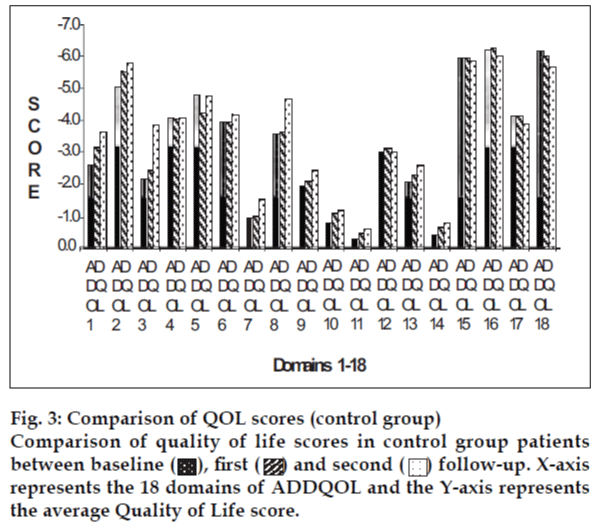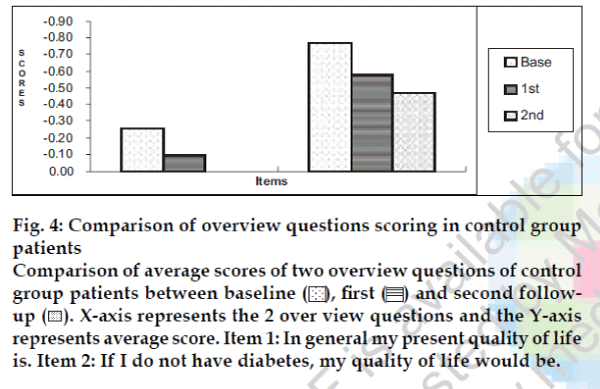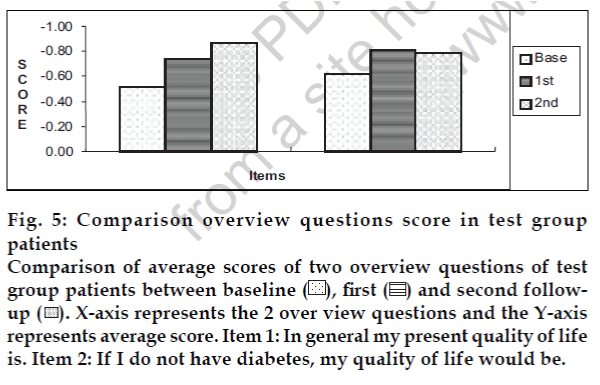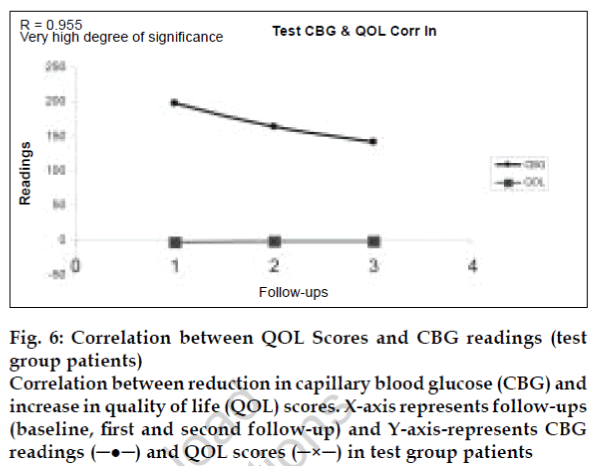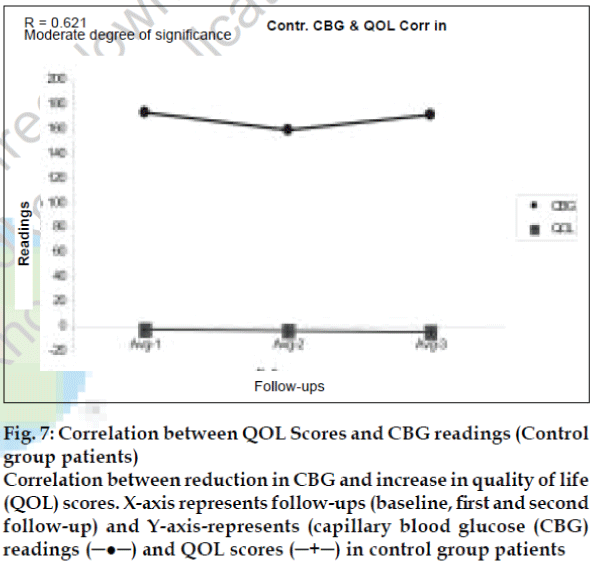- *Corresponding Author:
- B. G. Nagavi
J. S. S. College of Pharmacy, SS Nagara, Mysore - 570 015, India.
E-mail: adepu63@rediffmail.com
| Date of Submission | 17 July 2006 |
| Date of Revision | 19 June 2007 |
| Date of Acceptance | 13 July 2007 |
| Indian J. Pharm. Sci., 2007, 69 (4): 519-524 |
Abstract
This study was carried out to assess the influence of pharmacist provided patient counseling on patients' perception about the disease management and quality of life in type 2 diabetes mellitus patients. The present study was a randomized, prospective controlled study conducted over a period of six months in two community pharmacies in Calicut, Kerala, India. A total of seventy (48 male and 22 female) type 2 diabetes mellitus patients were enrolled and randomized into test and control groups. Patients in the test group received patient counseling and patient information leaflets from the pharmacist, where as the control group patients received the counseling and patient information leaflets only at the end of the study. After the baseline, two follow-ups were made with sixty days interval between the follow-ups. During each visit patient's random capillary blood glucose was measured by using a standard Glucometer. Suitably designed and validated knowledge, attitude and practices questionnaire was administered at baseline and final follow up for both test and control group patients to assess the disease management awareness. Audit of diabetes-dependent quality of life questionnaire was administered to measure the quality of life in both control and test group patients at each follow up. At the end of the study, knowledge, attitude and practices scores found markedly improved in test group patients. Mean capillary blood glucose levels were decreased in test group ( P <0.05) and an improvement in mean quality of life scores ( P <0.05) was observed. Where as a reduction of quality of life score ( P <0.05) and a non-significant increase of capillary blood glucose levels ( P >0.05) was observed in the control group patients. The correlation between the capillary blood glucose levels and quality of life scores were also found to be highly significant in the test group (r= 0.955). The results of the study suggests that, pharmacist provided patient counseling has an impact in improving the perception about disease, diet and life style changes and in turn on glycemic control and overall quality of life in diabetic patients. Pharmacist provided patient counseling might be considered as an important element in implementing the disease management program.
Keywords
Patient counseling, glycemic control, quality of life, diabetes mellitus, knowledge, attitude and practices, community pharmacist
Diabetes is the most common metabolic disorder in Indian community. It is a silent disease that has become more prevalent with increased age. Despite the advances in understanding the disease and its management, the mortality and morbidity of the disease is increasing. Many causes have been postulated for this rise, such as poverty, noncompliance, and poor follow-ups. Poorly controlled diabetes mellitus leads to damage of end organs such as kidneys, heart, brain, and eyes. This not only affects the quality of life of the patient but also increases the health expenditure to the individual and at large to the society [1].
The health problems associated with diabetes mellitus are arterial hypertension, over weight, ischemic cardiopathy, cardiac infarction, cerebro-vascular accidents, diabetic foot ulcers, blindness and secondary chronic renal failure. Chronic complications such as blindness, renal failure, and amputations influence the quality of life in Diabetes Mellitus patients [2].
Several studies have reported the positive impact of clinical pharmacists counseling on glycemic control and quality of life outcomes in diabetic population [3-6]. Studies such as Diabetes Control and Complication Trail (DCCT) [7] and United Kingdom Prospective Diabetes Study (UKPDS) [8,9] have conclusively demonstrated that a goal of normalization of blood glucose significantly reduces the risk of complications.
Patient counseling is a process that improves patient’s ability to cope up and make informed decisions regarding their disease and medication and motivate the patients to change their dietary habits and life style, which are harmful for their current health status [10]. Pharmacists are in a unique position to play vital role in patients’ medication adherence and quality of life improvement. The present study is designed to assess the impact of pharmacist provided patient counseling on treatment outcomes and quality of life in type-2 diabetes mellitus patients, by improving their knowledge, attitude and practice.
Materials and Methods
The study was conducted in two selected community pharmacies in Calicut, Kerala, India, after obtaining the pharmacists’ consent. This study was conducted over a period of six months. Inclusion criteria was applied to enroll type-2 diabetes patients of both gender and above 30 y of age and should be on treatment with either diet alone or diet and oral hypoglycemic agents (OHA) and who were ready to sign the consent form. Pediatric patients, pregnant women and patients with uncontrolled diabetes and with complications were excluded from the study. Institutional Research and Ethics Committee approved the study and issued a letter of permission to conduct the study.
Suitably designed and validated knowledge, attitude and practices (KAP) questionnaire was administered at baseline and at the final follow up on all the study patients to assess the disease awareness and its management. A disease-specific Audit of Diabetes-Dependent Quality of Life (ADDQOL-18) questionnaire was administered to assess the quality of life in all the study patients. Special permission was sought from the author of the questionnaire to use the same for the present study. This questionnaire was designed and validated to measure diabetic patients’ perception about the disease and its management and the impact of diabetes on their quality of life. The questionnaire includes 18 life domain specific items to be scored between (-9 to +9) depending upon the impact of the disease on the quality of life. The quality of life tool is divided into two fields - The impact field and the importance field. The product of impact and importance field is the total quality of life After the enrollment, patient’s demographic details, past and present medical and medication history was obtained in suitably designed patient profile form. The random capillary blood glucose levels of the patients were measured by using Johnson and Johnson one-touch Glucometer. The quality of life of each patient was assessed by using the ADDQOL questionnaire, at first visit and during each follow up (at sixty days interval). The patients in the test group received counseling on their disease, drugs, diet and life style modification and also patient information leaflet highlighting the disease, diet and life style modifications. The patients in the controlled group received pharmacist provided counseling and patient information leaf lets only at the end of the study.
Student “t” test was applied to assess the changes in quality of life scores and capillary blood glucose readings between test and control groups. Correlation coefficient method was used to correlate between the quality of life score and capillary blood glucose reading.
Results
After the scrutiny, using inclusion and exclusion criteria seventy patients were enrolled into the study and were randomized in to Test and Control groups. Among the total patients, 68.57% were males and 31.43% were females. The average age of the test group subjects was 51.45±12.27 and that of the control group was 53.77±10.35. The demographic details, disease history of the study population was shown in the Table 1. The treatment aspects of the study population are shown in Table 2.
| Control (n=35) Values in percentages |
Test (n=35) Values in percentages |
|
|---|---|---|
| Sex | ||
| Male | 62.9 | 74.3 |
| Female | 37.1 | 25.7 |
| Duration of disease | ||
| 1-6 mo | 42.3 | 23.0 |
| 7-12 mo | 17.1 | 28.6 |
| 1-2y | 14.3 | 17.1 |
| 2-5y | 14.3 | 20.0 |
| >5y | 32.0 | 11.4 |
Table 1: Demographic and disease history details of study
| Treatment aspects | Test (%) |
Control (%) |
|---|---|---|
| Not on any drugs | 5(7.14) | 6(8.57) |
| Metformin alone | 10(14.28) | 8(11.42) |
| Combination of sulphonylurea and metformin | 4(5.71) | 5(7.14) |
| Other combinations (Insulin/ | 4(5.71) | 5(7.14) |
| Thiazolidinedione/ Acarbose) | 4(5.71) | 5(7.14) |
| On drugs for controlling hypertension |
Table 2: Treatment aspects in study population
In KAP analysis, the percent of patients who answered correctly were found to be more in case of test group at the final follow-up compared to the baseline. Those relevant questions that the patients correctly answered have been given in the Table 3.
| Questions | Test Group % Pateints Correctly answered |
Control group % Patients correctly answered |
||
|---|---|---|---|---|
| Before counseling | After counseling |
At base line |
Last follow up |
|
| What is Diabetes Mellitus? | 43 | 65 | 40 | 40 |
| What is the main cause of Diabetes? | 20 | 87 | 26 | 24 |
| What is the correct method to measure blood sugar level? | 3 | 74 | 34 | 38 |
| Did you know, if diabetes not treated it lead to kidney problems? | 37 | 80 | 40 | 40 |
| Did you know, if diabetes not treated it lead to eye problems? | 60 | 87 | 68 | 65 |
| How often a Diabetic patient should check their eyes? | 3 | 70 | 3 | 3 |
| Will uncontrolled high Blood Pressure affect the functioning of kidneys? | 11.5 | 71 | 11.4 | 14 |
| How often a Diabetic patient should check their Blood Pressure? | 9 | 55 | 7 | 10 |
| Is weight reduction is useful in the controlling of Diabetes? | 21 | 68 | 20 | 20 |
| Are you aware of a condition in which the blood sugar level falls below the normal (Hypoglycemia)? | 45 | 84 | 40 | 42 |
| Do you know how to prevent/manage the hypoglycemic condition? | 40 | 84 | 37 | 34 |
Table 3: Comparison of pre and post data from kap questionnaire
Although glycosylated hemoglobin is the internationally accepted test to assess the glycemic control, due to time constraints and financial reasons, (as patients have to pay) capillary blood glucose (CBG) method was adopted in this study to assess the glycemic control. The average initial CBG levels of the test group patients were 198.31 mg/dl and that of the control group patients were 173.6 mg/dl. Capillary blood glucose levels of each patient were measured at each follow up. The average CBG levels of patients at each visit are shown in the fig. 1
The ADDQOL is 18-item questionnaire. It also consists of two additional over view questions. These two questions in general give an idea of present quality of life from the patient’ point of view. The quality of life of the patients in the test and control group was measured using the ADDQOL questionnaire during each visit and the average scores are shown in fig. 2 (Test group) fig. 3 (Control group). Scores of two overview questions are given in fig. 4 (Test group) and fig. 5 (Control group). The correlation between the QOL score and CBG levels are given in the fig. 6 (Test group) and fig. 7 (control group).
Fig. 4: Comparison of overview questions scoring in control group
patients
Comparison of average scores of two overview questions of control
group patients between baseline ( ), first (
), first ( ) and second followup
(
) and second followup
( ). X-axis represents the 2 over view questions and the Y-axis
represents average score. Item 1: In general my present quality of life
is. Item 2: If I do not have diabetes, my quality of life would be.
). X-axis represents the 2 over view questions and the Y-axis
represents average score. Item 1: In general my present quality of life
is. Item 2: If I do not have diabetes, my quality of life would be.
Fig. 5: Comparison overview questions score in test group
patients
Comparison of average scores of two overview questions of test
group patients between baseline ( ), first (
), first ( ) and second followup
(
) and second followup
( ). X-axis represents the 2 over view questions and the Y-axis
represents average score. Item 1: In general my present quality of life
is. Item 2: If I do not have diabetes, my quality of life would be.
). X-axis represents the 2 over view questions and the Y-axis
represents average score. Item 1: In general my present quality of life
is. Item 2: If I do not have diabetes, my quality of life would be.
Fig. 6: Correlation between QOL Scores and CBG readings (test
group patients)
Correlation between reduction in capillary blood glucose (CBG) and
increase in quality of life (QOL) scores. X-axis represents follow-ups
(baseline, first and second follow-up) and Y-axis-represents CBG
readings (─●─) and QOL scores (─×─) in test group patients
Fig. 7: Correlation between QOL Scores and CBG readings (Control
group patients)
Correlation between reduction in CBG and increase in quality of life
(QOL) scores. X-axis represents follow-ups (baseline, first and second
follow-up) and Y-axis-represents (capillary blood glucose (CBG)
readings (─●─) and QOL scores (─+─) in control group patients
Discussion
A total of seventy patients were enrolled into the study. Out of seventy patients, two expired, four patients were hospitalized and four patients did not respond. Remaining sixty patients (32 patients from test group and 28 patients from control group) completed all the follow-ups. The number of male patients was more than female. The maximum number of patients was found in the productive age range of 31-50 years (51.3%). If diabetes is not controlled at this age, it leads to early complications and which in turn affects the patient’s quality of life, patient’s family life, patient’s productivity and at large the society. As shown in the Table 1, 50% of patients enrolled in the study were diagnosed to have diabetes history of 1 month to 1 year. In addition 30% of patients were diagnosed to having diabetes from 2 to 5 years, and remaining 20% patients were with above 5 years history of diabetes.
Among the study population 31% of the male patients were smokers and 15% were alcoholics. Diabetes history among study population was one month to five years. Among them 25% were newly diagnosed and 20% were with 5 years of diabetes history. In the study population 12.85% were also on antihypertensive drugs in addition to drugs for controlling the diabetes.
The KAP questionnaire was developed to assess the perception of the patients about their disease (symptoms, cause, prognosis and complications) and to assess the changes in the perception after the pharmacist provided patient counseling. The KAP of the patients in the test group were tremendously improved after patient counseling, where as KAP levels remained more or less same in the control group. Most of the patients (31%) knew that blood glucose testing is a reliable method to assess their improvement. But due to financial constraints many patients confine to urine testing because it is cheap and self testing is possible. Patient counseling also motivated the patients to quit smoking and practice healthy life styles. This positive change has shown its impact on CBG readings and QOL scores.
The higher percentage of correct answers from patients with positive family history of diabetes was not surprising. A Study by Shobana et al.[12] showed that, patients with positive family history knew better about the role of hereditary, diet as a mode of therapy and also regarding the long term complications of diabetes mellitus. Similarly educational status improved the background knowledge. Paulose [13] carried out a disease awareness study in 400 literate diabetic patients in Kerala. The study found that although 80% of patients knew the symptoms of hypoglycemia and 76% knew what to do when they develop these symptoms, only 17% carried glucose packets with them during their travel, and 29% patients told that their doctors did not inform them about hypoglycemic complications. These studies suggest that it is essential to educate the patients regarding proper diet, exercise, glucose control, and periodic consultations. Nilsson et al. [14] carried out a study to examine the relationship between educational level and mortality among diabetics, the study enrolled 39055 subjects aged 25-75 years for a period of 16 years. The study concluded that low educated subjects had a 40% excess cause of mortality compared with high educated subjects.
Random CBG method was adopted in this study to assess the glycemic control. A significant reduction in the capillary blood glucose levels of the patients was observed in test group (P<0.05) in the first follow-up and (P<0.001) in the final visit, while no significant changes were observed in the control group patients. Many studies have shown that better glycemic control in Type-2 diabetes mellitus is associated with fewer physical symptoms, better mood and better well being, which, ultimately influences overall improved quality of life [15] and improved economic benefits [16].
An ADDQOL was used to assess the changes in the quality of life of the patients in study population. From the study, it was found that all the domains mentioned in the questionnaire were affected by the diabetes. The changes in the average scores of each group (test and control) were observed. In the test group the changes in the quality of life score was more significant (P<0.001) where as no significant changes were observed in the control group patients. In the study, it was found that the most commonly affected domains of quality of life questionnaire in the study population were - freedom to eat, freedom to drink and enjoyment of food, followed by family life and sex life of the individuals. Remaining domains such as, ease of travel, working life and finance were also affected significantly.
The landmark Diabetes Control and Complication Trials (DCCT-1996) and United Kingdom Prospective Diabetes Study (UKPDS) have conclusively demonstrated that glycemic control definitely affects the appearance and progression of chronic diabetes complications. This study also observed the correlation between quality of life score and CBG level. There is very high significance (r= -0.955) in case of test group, where the reduction in CBG level and improvement in the quality of life score was observed. But in the control group, a moderate degree of significance (r= 0.621) between capillary blood glucose level and quality of life scores and an increase in capillary blood glucose level and decrease in the quality of life score was observed.
Diabetes Mellitus has been referred as an emerging epidemic health problem. Poorly controlled diabetes mellitus affects the end organs such as kidneys, heart and eyes. These complications have a tremendous impact on quality of life and health care costs of the individual and at large to the society. Effective treatment of chronic diseases like diabetes mellitus requires life long adherence to medication regimen, exercise and diet.
Along with other health care professionals, role of pharmacist as diabetic counselor is much appreciated in many developed countries [17]. Pharmacist’s involvement in patient care has shown reduced number of hospital admissions and emergency department visits, and improved health status of the patients and their quality of life. This study reveals that patient counseling by pharmacists not only improves the knowledge, attitude and practices of the patients towards their disease management but also increases their quality of life.
Acknowledgements
We thank J. S. S. Mahavidyapeetha, Mysore for providing the necessary funding and support. We express our special thanks to Dr. Claire Bradley, Professor and Head, Department of Psychology, Royal Hallow University of London, UK, for providing and permitting us to use the diabetic specific quality of life questionnaire. We also express our sincere thanks to Dr. G. Parthasarathi, Professor and Head, Department of Pharmacy Practice, JSS College of Pharmacy, Mysore, for his valuable suggestions and advices during the study. We also thank Mr. D. H. Panchakshrappa Gowda., the institutional statistician and Dr. B. S. Srinivasan, Professor of Bio statistics, JSS Medical College for their statistical support. Special tribute to Mr. Abdul Rasheed one of the authors, who is no more.
References
- Testa MA, Donald C. Simonson MB. Health economic benefits and quality of life during improved glycemic control in patients with type-2 Diabetes Mellitus- A randomized, controlled, double blind trial. JAMA 1998;280:1490-6.
- Whitman. LL. Impact of pharmacist counseling in type 2 Diabetes Mellitus patients.
- Coat Senior EA. Management of patients with type 2 diabetes by pharmacist in primary care clinics. Ann Pharmacother 1998;32:636-41.
- Tiggellar JM. Protocol for the treatment of essential hypertension and type 2 diabetes mellitus by pharmacist in ambulatory care clinics. Drug Intel Clin Pharm 1987;21:521-9. Back to cited text no. 4
- Zettervall DK. Recognition, treatment and management of acute diabetes complications in long term care facilities. The Consultant Pharmacist 2000;15:397-416.
- Jaber LA, Halappy H, Fernet M, Thammalapalli S, Divakaren H. Evaluation of pharmaceutical care model on diabetes management. Ann Pharmacother 1996;30:238-43.
- Diabetes control and complication trial group, Influence of intensive diabetes treatment on quality of life outcomes in the diabetes control and complication trial. Diabetes Care 1996;19:195-203.
- U.K. Prospective Diabetes study group, Quality of life in type 2 diabetic patients is affected by complications but not by intensive policies to improve blood glucose or blood pressure control. Diabetes Care 1999;22:1125-36
- U.K. Prospective Diabetes study group. Glycemic control with Diet, Sulfonylurea, Metformin or Insulin in patients with type-2 Diabetes Mellitus. J Am Med Assn 1999;281:2005-12.
- Lewis RK, Lasack NL, Lambert BL. Connor SE. Patient counseling- A focus on maintenance therapy. Am J Health Syst Pharm 1997;54:2084-97.
- Bradley C, Todd C, Gorton C, Symonds E, Martin A, Plowright R. Development of individualized questionnaire measure of perceived impact of diabetes on quality of life. Qual Life Res 1999;8:79-91.
- Shobana R, Pramila L, Shyamala P, Mohan V, Ramachandren A, Vishwanadhen M. Assessment of background knowledge of diabetes mellitus in diabetic patients. J DiabAssn India 1989;22:70-4.
- Paulose KP. Disease awareness study in diabetic patients. Asian J Diabetol 2000;2:15-9.
- Nilsson PM, .Johnsson SE, Sandquist J. Low educational status is a risk factor for mortality among diabetic people. Diabet Med 1998;15:213-9.
- Ferdinad EE, Vander D, Mico D, Neeling DE, Franyl JS, Petter A, et al . Symptoms and well being in relation to glycemic control in type2 diabetes. Diabetes Care 1996;19:204-10.
- Testa MA, Simonson DC, Turner RR. Valuing quality of life and improvement in glycemic control in people with type-2 diabetes. Diabetes Care 1998;21:C44-52.
- Moffat T. Point of care testing in the community pharmacy. Pharm J 2001:267;267-8.
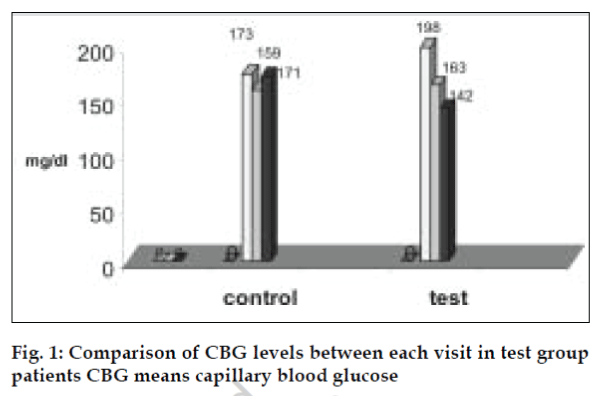
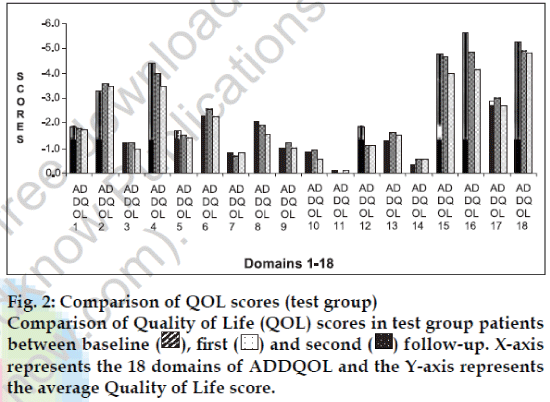
 ), first (
), first ( ) follow-up. X-axis
represents the 18 domains of ADDQOL and the Y-axis represents
the average Quality of Life score.
) follow-up. X-axis
represents the 18 domains of ADDQOL and the Y-axis represents
the average Quality of Life score.